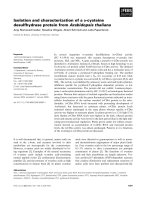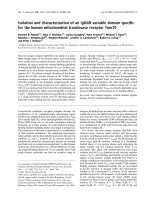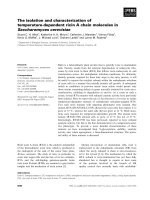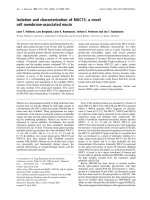Isolation and characterization of multifunctional yeast as plant probiotics for better crop nutrition in pulses
Bạn đang xem bản rút gọn của tài liệu. Xem và tải ngay bản đầy đủ của tài liệu tại đây (213.8 KB, 8 trang )
Int.J.Curr.Microbiol.App.Sci (2019) 8(1): 2711-2718
International Journal of Current Microbiology and Applied Sciences
ISSN: 2319-7706 Volume 8 Number 01 (2019)
Journal homepage:
Original Research Article
/>
Isolation and Characterization of Multifunctional Yeast as Plant Probiotics
for Better Crop Nutrition in Pulses
B. Jeberlin Prabina1*, K. Kumutha2, R. Anandham3 and P. Durga2
1
Department of SS&AC, AC&RI., Killikulam, India
Department of Agriculture Microbiology, AC&RI., Madurai, India
3
Department of Agriculture Microbiology, TNAU, Coimbatore, India
2
*Corresponding author
ABSTRACT
Keywords
Isolation,
Characterization,
Multifunctional,
Yeast, Plant
Article Info
Accepted:
17 December 2018
Available Online:
10 January 2019
Pulses being important source of protein and micronutrients find its place in national food
security. Plant probiotic microbes play an important role in producing safe and nutritious
pulses. In this work we characterized plant probiotic yeast from different sources and
investigated its multifunctional activity in promoting the growth of black gram. Of the
twenty isolates, two isolates one from the seeds of pomegranate (POY5) and the other one
from grapes (GRY4) were selected for the study. Alignment results of the 18S rDNA
sequences using ITS1 and ITS4 revealed POY5 as Pichia kudriavzevii and GRY4 as
Issatchenkia terricola. Interestingly, both the isolates were positive for the plant growth
promoting characteristics such as phosphorus solubilization, zinc solubilization, auxin,
siderophore, ACC deaminase and hydrogen cyanide production that signify them as plant
probiotics. Seed imbibition with the probiotic yeast recorded an increase in germination
per cent of 9 and 8.8% by POY5 and GRY4 respectively over control. Significant
difference in root and shoot length of black gram seedlings treated with probiotic yeast
were recorded. It is concluded that these multi-functional yeast could be exploited as bioformulation for better crop nutritional security in black gram.
Introduction
It is interesting to note that the rhizosphere of
plants is home to diversified group of
microbes many of which interact with each
other and with the plants either way. With the
exploration of the beneficial role of these
microbes, called as plant growth promoting
microbes, significant interest has been created
among the researchers for the exploitation of
these microbes for better and sustainable
agriculture. The benefits enjoyed by the plants
up on inoculation with these beneficial
microbes include improved availability of
nutrients, reduced infection by pathogens and
enhanced resistance to abiotic stress such as
drought, temperature and salinity (Riggs, et
al., 2001; Martinez Viverol et al., 2010; Kim
et al., 2011 ).
The common effects that could be realised in
plants due to the beneficial microbes are
2711
Int.J.Curr.Microbiol.App.Sci (2019) 8(1): 2711-2718
improvement in germination, seedling vigor,
biomass production, root hair development,
photosynthetic efficiency, improved plant
biochemical composition flowering, and yield.
Among the growth promoting microbes,
beneficial bacteria commonly referred as Plant
Growth Promoting Bacteria (PGPR) (Vessey,
2003) are widely exploited and has got much
attention.
Plant Growth Promoting Fungi (PGPF) is also
gaining importance and is reported to improve
the plant quality (Zhou et al., 2018) that fungi
and yeast stand in line for exploration with
much potential for improving the food quality.
Yeasts are unicellular fungi that are distributed
more in rhizosphere region than the nonrhizosphere region (Botha, 2011).
A diverse range of yeasts exhibit plant growth
promoting characteristics, including control of
pathogens (El-Tarabily, 2004; El-Tarabily and
Sivasithamparam, 2006; Sansone et al., 2005);
Plant growth hormone production (Nassar et
al., 2005); Phosphorus solubilisation (Falih
and Wainwright, 1995; Mirabal Alonso et al.,
2008); Nitrogen and sulphur oxidation (Falih
and Wainwright, 1995); and siderophore
production (Sansone et al., 2005). Here, our
aim of investigation was to identify potential
multifunctional plant growth promoting yeast
from different sources that would help in
sustaining the black gram nutrition for better
tomorrow.
Materials and Methods
A total of twenty different yeast were isolated
from grapes, pomegranate, tomato and black
gram samples using the Yeast Extract Peptone
Dextrose (YEPD) agar medium supplemented
with 250 µg/ml chloramphenicol with pH 6.56.7 (Nassar et al., 2005). Among the twenty,
molecular characterization was done for the
two selected efficient yeast isolates by ITS 1/
ITS 4 sequencing.
Molecular characterization of the yeast
isolates
The genomic DNA from the selected isolates
namely GRY4 and POY5 was isolated using
the standard protocol using HiPurATM Yeast
Genomic DNA Purification Kit.
Genomic DNA of the yeast isolates were
amplified using ITS1 (5’-TCCGTAGGTG
AACCTGCGG -3’) and ITS4 (5’-TCCTCCGCT
TATTGATATGC -3’). The amplified product
was sequenced using fluorescent dye
terminator method (ABI prism equipment and a
BigdyeTM Terminator cycle sequencing ready
reaction kit V.3.1). Sequencing was performed
in Macrogen, South Korea. Sequences were
aligned and identified the closest neighbor
using NCBI Basic Local Alignment Search
Tool (BLAST).
Plant growth promoting characteristics of
yeast isolates
Phosphorus solubilization by the yeast
isolates
The phosphorus solubilization ability of the
yeast isolates was quantitatively determined
by inoculation in NBRI-BPB medium,
2001supplemented with 0.5% insoluble
phosphorus as tri-calcium phosphate and
incubated at 30±1°C for 3 days.
The pH of the medium was adjusted to 7.0
before sterilization in autoclave. Flasks were
inoculated with metabolically active yeast
culture @ 1% having a population of 8 ×105
cells. The cultures were maintained under
aerobic condition with shaking (100 rpm) for
3 days at 30 °C. The samples were centrifuged
at 5000×g for 15 min and the pH and soluble P
in the supernatant were analysed. The pH was
measured with a PHM210 meter. Soluble
phosphorus was measured using the ascorbic
acid method (Olsen et al., 1954).
2712
Int.J.Curr.Microbiol.App.Sci (2019) 8(1): 2711-2718
Indole acetic acid production by the yeast
isolates
IAA production was estimated using the
modified method of Gordon and Weber, 1951.
The isolates were grown overnight in YEPD
broth and transferred to fresh broth
supplemented with 1% tryptophan incubated
for 48h at 30±1°C in a rotary shaker. Then, the
cultures were centrifuged at 15,000 rpm for 10
min. One millilitre of the supernatant was
mixed with 2 mL of Fe-H2SO4 solution (1 mL
of 0.5 M FeCl3·6H2O in 75 mL of 6.13 M
H2SO4) and incubated in the dark for 45 min.
under dark condition. The reddish pink colour
developed was read at an absorbance of 530
nm (UV-160 A spectrophotometer, Shimadzu,
Japan) and the amount of IAA produced was
calculated from the standard graph obtained
with 0.5 to 10 g ml-1 of IAA.
Zinc solubilization ability of the yeast
isolates
Zinc solubilization assay was carried out in
culture medium supplemented with 0.1%
insoluble zinc compound as ZnO (Bunt and
Rovira, 1955). Flasks were inoculated with
metabolically active yeast culture @ 1%
having a population of 8 ×105 cells. The
cultures were maintained under aerobic
condition with shaking (100 rpm) for 5 days at
30°C. The samples were centrifuged at
5000×g for 15 min and the pH and soluble
zinc in the supernatant were analysed through
Inductively Coupled Plasma Optical Emission
Spectroscopy (ICP-OES) Teledyne Leeman
Labs, Prodigy Spec., USA.
Siderophore
isolates
production
by
the
yeast
The modified Chrome azurol S (CAS) assay
(Milagres et al., 1999) was used to test the
ability of yeast isolates to produce iron
binding compound siderophores in solid
medium. CAS blue agar and YEPD agar plates
were prepared. Half of the YEPD medium was
cut and replaced by CAS blue agar. The yeast
isolates were spot inoculated on to YEPD agar
half near the border line and plates were
incubated in the dark at 30±1°C for 10 days.
Un-inoculated CAS agar plate served as
control. The CAS reaction was determined by
measuring the position or distance of the
advancing colour change (in mm) in the CAS
blue agar starting from the border line
between the two halves during incubation
period of 10 days (Schwyn and Neilands,
1987).
Hydrogen cyanide (HCN) production by
the yeast isolates
The yeast isolates were streaked onto King’s
B medium amended with glycine. Whatman
No.1 filter paper soaked in picric acid (0.05%
solution in 2% sodium carbonate) was placed
inside the lid of each Petriplate. The plates
were then sealed air-tight with parafilm and
incubated at 30±1°C for 48 h. A change in
colour of the filter paper from deep yellow to
reddish-brown indicates the production of
Hydrogen cyanide (Bakker and Schipperes,
1987).
ACC deaminase activity of the yeast isolates
The presence of ACC deaminase activity was
determined as described by Dell’Amico et al.,
(2005). About 24 h old yeast isolates grown in
nitrogen free DF medium with ACC as carbon
source. After inoculation, the cultures were
grown at 28°C with continuous shaking and
optical density at 600 nm was read for 8 days.
Growth indicates the potential for the
microorganism to use ACC as nitrogen source
through deamination.
Results and Discussion
A total of 20 yeast isolates were obtained from
tomato, grapes, pomegranate and black gram.
2713
Int.J.Curr.Microbiol.App.Sci (2019) 8(1): 2711-2718
All the isolates were tested for the plant
growth promoting traits such as production of
IAA, siderophore, hydrogen cyanide, zinc
solubilization and phosphate solubilization.
Based on the results two isolates viz., GRY4
and POY5 that were positive for recognized
plant growth promoting traits were selected
for further plant growth promotion of black
gram under in vitro conditions. The results are
presented in Table 1.
S.
Yeast isolates Closest Neighbour
No.
GRY4
Issatchenkiaterricola
1.
POY5
Pichiakudriavzevii
2.
Studies on plant growth promoting
characteristics of the yeast isolates
The ability to solubilize tri-calcium phosphate
by the yeast isolates was more on 3rd day of
incubation with a recorded value of 386 and
311g ml-1 by Issatchenkia terricola and
Pichia kudriavzevii respectively. The earlier
report by Narsian et al., (2010) documented
solubilization of 697 µg ml-1 of phosphorus at
11 days of incubation by Pichia
subpelliculosa.
Among the two test isolates, Pichia
kudriavzevii produced higher IAA of about
21.62µg ml-1 and 18.81µg ml-1 by
Issatchenkia terricola. Amprayn et al., 2012
reported a quantity of 2.6 µg ml-1 IAA
production by Candida tropicalis whereas Sun
et al., 2014 recorded IAA production of
147.4±2.7 µg ml-1 in A. pullulans with
exogenous tryptophan. The variation in the
quantity is due to the inherent capacity to
synthesise IAA by different genera of yeast.
The quantity of solubilization of zinc by the
yeast isolates was studied under in-vitro
Molecular identification of the efficient
isolates of yeast
Genomic DNA of the yeast isolates were
amplified using ITS1 and ITS4. Based on
partial 18SrRNA sequencing, these yeast
isolates were identified. The isolates were
submitted in Genbank (NCBI) and accession
numbers were obtained. The amplified
sequence of GRY4 showed 98% similarity to
Issatchenkiaterricola (363 bp) and POY5
showed 93% similarity to Pichiakudriavzevii
(506 bp).
Length of the
sequence (bp)
363
506
%
Similarity
98
93
NCBI
accession No.
MG547741
MG547742
condition with zinc oxide that recorded a
quantity of 174 ± 1.23g ml-1 to 181 ± 1.76g
ml-1. Earlier work by Panneerselvam et al.,
(2013) estimated a solubilization quantity of
232.4±8.46 µg ml-1 with Pseudomonas putida.
Variation between the isolates to solubilize the
same or different source of insoluble zinc
compounds has been noticed by earlier
workers also (Di simine et al., 1998; Fasim et
al., 2002; Saravanan et al., 2003; Shahab and
Ahmed, 2008).
Solubilization of zinc by the yeast isolates
was attributed to the production of organic
acid that has been realised with the shift in pH
of the medium from 7.0 to 3.5.
Among the desirable characteristics of a biocontrol agent, ability for siderophore
production is important as it could sequester
the iron, making it unavailable for pathogens.
Vero et al., (2013) evaluated the production of
siderophore in yeasts from Antartic soil and
Spadaro et al., (2011) attributed siderophore
production by the yeast isolate Metschnikowia
pulcherrima MACH1 for its bio-control
capacity.
2714
Int.J.Curr.Microbiol.App.Sci (2019) 8(1): 2711-2718
Siderophores, such as pyoverdine and
pyochelin, are biologically active derivatives
of small peptides or peptide-like molecules
(Byers and Arceneaux, 1998). Viable cells of
S. cerevisiae possess heme molecules that are
connected with inducible ferri-reductase
activity and iron uptake (Lesuisse and Labbe,
1989). Though the siderophore production and
uptake had been demonstrated in the yeast
Saccharomyces cerevisiae, the mechanism
was due to the ferric ion reduction system, by
Fre1p and Fre2p proteins at the cell surface,
followed by the uptake of iron via the high
and low-affinity iron uptake systems
(Heymann et al., 2002). In the present study,
not all the twenty isolates were positive for
siderophore production. But the selected two
isolates were able to release siderophore,
making the yeast isolates a multifunctional
plant growth promoter.
Table.1 Plant growth promoting traits of the yeast isolates. Values are means of three replicates
± standard errors (SE)
PGP traits studied
Issatchenkiaterricola
(GRY4)
Phosphorus solubilization 386 ± 14
[Total P release (g ml-1)]
18.81 ± 0.04
IAA production [µg ml-1]
Zinc solubilization [Zn 174 ± 1.23
release (g ml-1)]
2.4 ± 0.002
Siderophore production
[nmol
α-Ketobutyrate
released min mg-1 of
protein]
Hydrogen
cyanide Positive
production
Positive
ACC deaminase
Plant growth promoting rhizobacteria
produce chemical compounds with different
benefits for the plant. Among them
hydrogen cyanide is recognized as a biocontrol agent, based on its toxicity against
plant pathogens and ability to form
complexes with transitional metals in the
mineral substrate, (Rijavec and Lapanje,
2016), in which HCN is involved in
increasing the availability of phosphates by
metal chelation. Wongfun et al., (2014)
recorded the role of hydrogen cyanide in
mobilization of elements from rock
phosphate minerals. Both the two test
isolates,
Pichia
kudriavzevii
and
Issatchenkia terricola were positive for
hydrogen cyanide production that the ability
Pichiakudriavzevii
(POY5)
311 ± 10
21.62 ± 0.06
181 ± 1.76
2.69 ± 0.014
Positive
Positive
to produce HCN could be considered as a
growth promoting trait. The function of
ACC deaminase in plant-microbe systems
has been well studied and resulted in
decreased
ethylene
production
and
subsequent stimulation of plant root
elongation (Glick et al., 2007; Yim et al.,
2010).
Amprayn et al., (2012) the ability of the soil
yeast Candida tropicalis HY, to utilize
aminocyclopropane-1-carboxylate (ACC) as
sole source of nitrogen, indicative of high
ACC deaminase activity.
The studies with Pichia kudriavzevii and
Issatchenkia terricola indicated the ability
2715
Int.J.Curr.Microbiol.App.Sci (2019) 8(1): 2711-2718
of the yeast isolates to utilize ACC as carbon
source, proving the ability to have ACC
deaminase activity.
The work and the results that were obtained
authenticates the prospects of yeast to be
developed as formulation for black gram to
ensure crop nutritional security.
Seedling assay in black gram under in
vitro condition
References
For seed imbibition study along with the
best isolates POY4 was also included to
compare the performance among the yeast
isolates. Seed imbibition with yeast isolates
influenced the germination of seeds
significantly. Seed imbibition with the
isolate POY5 recorded the higher
germination of 77% compared to the uninoculated control (68 %) that accounted for
an increase in germination per cent of 9 and
8.8% by POY5 and GRY4 respectively over
control. Root length was significantly
influenced by imbibition treatments. Higher
root length was observed in GRY4. In case
of shoot length, though inoculation exhibited
significant influence, all the isolates were on
par. In turn, significant influence on vigour
index was observed due to seed imbibition
with yeast isolates and the maximum was
observed with POY5 isolate (3619) against
control (2257) seedlings. Seeds imbibed
with the yeast isolate POY4 had not
significantly influenced the seedling
compared to un-inoculated control. The
overall results revealed the positive
influence of yeast isolates on seedling
vigour of black gram.
Botha, A., 2011. The importance and
ecology of yeasts in soil. Soil Biol.
Biochem., 43, 1–8.
Bunt and Rovira, 1955. Studies of some sub
Antarctic soils. J. Soil Sci., 6:119-128
Byers, B. R. and J. E. L. Arceneaux, 1998
In: Iron Transport and Storage in
Microorganisms, Plants, and Animals
(Sigel, A., and Sigel, H., eds) 35: 3766, Marcel Dekker, New York
Dell’Amico, E., L. Cavalca and V.
Andreoni.
2005.
Analysis
of
rhizobacterial
communities
in
perennial Graminaceae from polluted
water meadow soil and screening of
metal-resistant,
potentially
plant
growth-promoting bacteria. FEMS
Microbiol. Ecol., 52:153–162.
Di Simine, C. D., J. A. Sayer and G. M.
Gadd. 1998. Solubilization of zinc
phosphate by a strain of Pseudomonas
fluorescens isolated from forest soil.
Biol. Fertile. soils, 28: 87-94.
El-Tarabily, K.A., 2004. Suppression of
Rhizoctoniasolani diseases of sugar
beet by antagonistic and plant growthpromoting yeasts. J. Appl. Microbiol.
96: 69–75.
El-Tarabily, K.A and K. Sivasithamparam.
2006. Potential of yeasts as bio-control
agents of soil-borne fungal plant
pathogens and as plant growth
promoters. Mycoscience. 47: 25–35
Falih, A.M., Wainwright, M., 1995.
Nitrification, S-oxidation and Psolubilization by the soil yeast
Williopsis
californica
and
by
Saccharomyces cerevisiae. Mycol.
Res. 99, 200–204.
Fasim, F., N. Ahmed, R, Pasons and G.M.
In conclusion, the plant based yeasts
IssatchenkiaterricolaGRY4 and Pichia
kudriavzevii POY 5 are multi-functional that
they could solubilize phosphorus, zinc
nutrients solubilization; produce auxin,
siderophore, ACC deaminase and hydrogen
cyanide that either directly or indirectly
affect the plants. Significant influence on
vigor index of black gram on seed
imbibition with the yeast isolates strongly
substantiates the growth promoting nature of
the yeast isolates.
2716
Int.J.Curr.Microbiol.App.Sci (2019) 8(1): 2711-2718
Gadd. 2002. Solubilization of zinc
salts by a bacterium isolated from the
air environment of a tannery. FEMS
Microbiol. Lett., 213: 1-6
Glick, B.R., Z. Cheng, J. Czarny and J.
Duan. 2007. Promotion of plant
growth by ACC deaminase-producing
soil bacteria. European Journal of
Plant Pathology, 119: 329–339.
Gordon, S.A and R. P Weber. 1951.
Colorimetric estimation of indole
acetic acid. Plant Physiol. 26: 192–195
Heymann, P., M. Gerads, M. Schaller, F.
Dromer, G. Winkelmann and J.F.
Ernst. 2002. The siderophore iron
transporter of Candida albicans
(Sit1p/Arn1p) mediates uptake of
ferrichrome-type siderophores and is
required for epithelial invasion.
Infection and Immunity, 70: 5246–
5255
Kim, Y, C.J. Leveau, B.B, McSpadden
Gardener, E.A. Pierson, L.S. Pierson
and C.M. Ryu III. 2011. The
multifactorial basis for plant health
promotion by plant associated
bacteria. Appl. Environ. Microbiol.,
77: 1548–1555.
Lesuisse, E and P. Labbe. 1989. Reductive
and non-reductive mechanisms of iron
assimilation
by
the
yeast
Saccharomyces cerevisiae. J. Gen.
Microbiol., 135: 257–263.
Martinez-Viverol, O., M.A. Jorquera, D.E.
Crowley, G. Gajardo and M.L. Mora.
2010. Mechanisms and practical
considerations involved in plant
growth promotion by rhizobacteria. J.
Soil. Sci. Plant Nutr., 10: 293–319.
Milagres, A.M.F., A. Machuca and D.
Nepoleao.
1999.
Detection
of
siderophore production from several
fungi and bacteria by a modification of
chrome Azurol S (CAS) agar plate
assay. Journal of Microbiological
methods. 37(1):1-6
Mirabal Alonso, L., D. Kleiner, and E.
Ortega. 2008. Spores of the
mycorrhizal fungus Glomus mosseae
host yeasts that solubilize phosphate
and
accumulate
polyphosphates.
Mycorrhiza 18: 197–204.
Narsian, V., A.A.S.M Samaha and H.H.
Patel.
2010.
Rock
phosphate
dissolution by specific yeast. Indian
Journal of Microbiology, 50: 57–62.
Nassar, A.H., K.A. El-Tarabily and K.
Sivasithamparam. 2005. Promotion of
plant growth by an auxin-producing
isolate of the yeast Williopsissaturnus
endophytic in maize (Zeamays L.)
roots. Biology and Fertility of Soils,
42: 97–108.
Olsen, S.R., C.V. Cole, F.S. Watanabe and
L.A. Dean. 1954. Estimation of
available phosphorus in soils by
extraction with sodium bicarbonate.
U.S. Dep. of Agric. Circ.,939
Panneerselvam, P.,B. Sarith, S. Mohanda,
K.K. Upret, S. Poovarasa, V.V.
Sulladmat and R. Venugopalan. 2013.
Biological
Agriculture
and
Horticulture, 29(2): 118- 131.
Riggs, P. J., M. K. Chelius, L. Iniquez, S.M.
Kaeppler and E. W. Triplett. 2001.
Enhanced maize productivity by
inoculation with diazotrophic bacteria.
Aust. J. Plant Physiol., 28: 829-836.
Rijavec, T., and A. Lapanje. 2016.
Hydrogen cyanide in the rhizosphere:
not suppressing plant pathogens, but
rather regulating availability of
phosphate. Frontiers in Microbiology,
7 Pp.
Sansone, G.,I. Rezza, V. Calvente, D.
Benuzzi and M.I.S.D. Tosetti. 2005.
Control of Botrytis cinerea strains
resistant to iprodione in apple with
rhodotorulic
acid
and
yeasts.
Postharvest Biol. Tech. 35: 245–251.
Saravanan, V., S. Subramoniam and S.
Anthoni Raj. 2003. Assessing in-vitro
2717
Int.J.Curr.Microbiol.App.Sci (2019) 8(1): 2711-2718
solubilisation potential of different
zinc solubilizing bacterial isolates.
Brazilian. J. Microbiol., 34: 121- 125.
Schwyn, B and J.B. Neilands. 1987.
Universal Chemical Assay for the
Detection and Determination of
Siderophores.
Analytical
Biochemistry, 160: 47-56
Shahab, S and N. Ahmed, N. 2008. Effect of
various parameters on the efficiency of
zinc phosphate solubilisation by
indigenous bacterial isolates. African
J. Biol., 7: 1543- 1549.
Spadaro, D., D. Zhang, A. Garibaldi and M.
Gullino. 2011. The Role of
Competition for Iron and Cell Wall
Degrading Enzymes in Mechanism of
Action of Postharvest Bio-control
Agents. ActaHorticulturae (ISHS).
905: 87-102.
Stewart, W.D., G.P. Fitzgerald and R.H.
Burris. 1967. In situ studies on N2
fixation using the acetylene reduction
technique. Proc. Natl. Acad. Sci. U S
A. 58(5): 2 071–2078.
Sun, P.F., W.T. Fang, L.Y. Shin, J.Y. Wei
and S.F. Fu. 2014. Indole-3-Acetic
Acid- Producing Yeasts in the
Phyllosphere of the Carnivorous Plant
Droseraindica L. PLoS ONE, 9:114–
196.
Vero, S., G. Garmendia,B.Gonzalez, O.
How to cite this article:
Bentancur and M. Wisniewski. 2013.
Evaluation of yeasts obtained from
Antarctic soil samples as bio-control
agents for the management of
postharvest diseases of apple (Malus
domestica). FEMS Yeast Research, 13:
189-190.
Vessey, J.K., 2003. Plant growth promoting
rhizobacteria as bio-fertilizers. Plant
Soil. 255: 571–586.
Wongfun, N., M. Plötze, G. Furrer and H.
Brandl. 2014. Weathering of granite
from the Damma glacier area: the
contribution of cyanogenic bacteria.
Geomicrobiology Journal, 31: 93–100
Yim, W.J., P.S. Chauhan, M. Madhaiyan,
S.C. Tipayno, T.M.Sa. 2010. Plant
growth promontory attributes by 1aminocyclopropane-1-carboxylate
(ACC)
deaminase
producing
Methylobacterium
oryzae
strains
th
isolated from rice. In: 19 World
Congress of Soil Science, Soil
Solutions for a hanging World,
Brisbrane, Australia, pp. 96–99.
Zhou, L.S., K. Tang and S.X. Guo. 2018.
The Plant Growth Promoting Fungus
(PGPF) Alternaria sp. A13 markedly
enhances Salvia miltiorrhiza root
growth
and
active
ingredient
accumulation under greenhouse and
field conditions. Int. J. Mol Sci., 16:19
Jeberlin Prabina, B., K. Kumutha, R. Anandham and Durga, P. 2019. Isolation and
Characterization of Multifunctional Yeast as Plant Probiotics for Better Crop Nutrition in
Pulses. Int.J.Curr.Microbiol.App.Sci. 8(01): 2711-2718.
doi: />
2718









